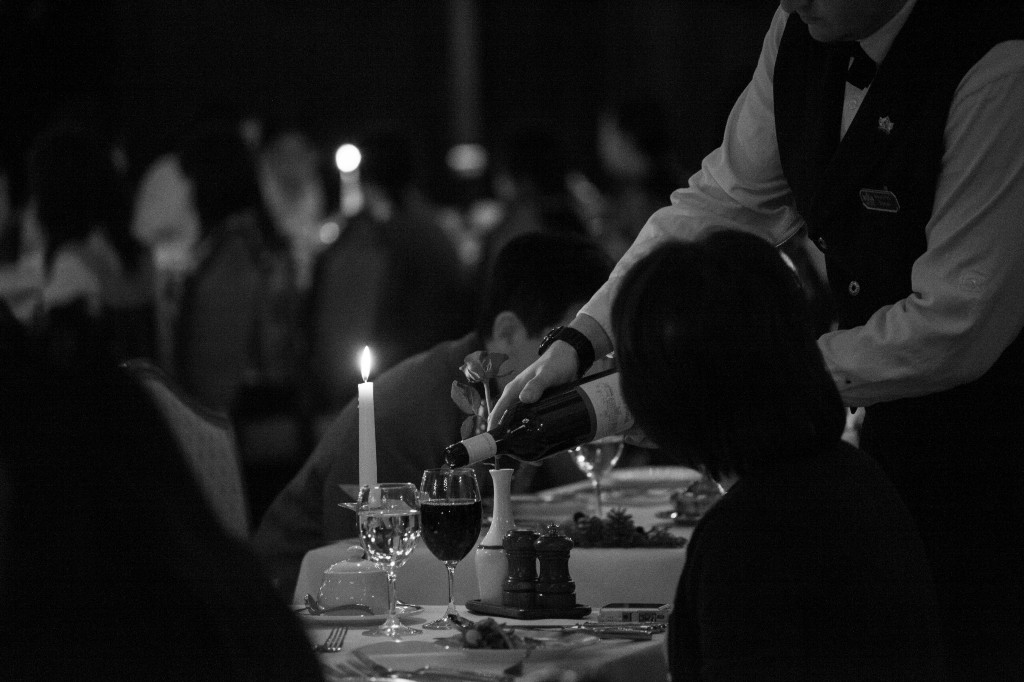A Pilgrim's Progress
How realistic is ‘Sweetbitter’ about the hospitality industry?

Last year, hospitality mogul Danny Meyer opened a new restaurant in the recently relocated Whitney Museum in New York’s Meatpacking District. The New York Times food critic Pete Wells opened his review of Untitled with some context for Meyer’s burgeoning armada of expensive, middlebrow eateries. Wells said the group comprises “polite restaurants where polite people are in very little danger of being challenged or provoked. Although Mr. Meyer has worked to make his name synonymous with hospitality, what his restaurants sell above all is reassurance.”
I’m no fan of Wells, but I had to admit, there’s something shrewd in this comparison. Whether it’s fine art or fine dining, the fundamental imperative of middlebrow culture is the same: give the people what they want. If the key to satisfying popular demand is to offer the expected, however, the trick is to not to get caught being boring.
Meyer has made a killing in the restaurant industry by striking just this balance. Stephanie Danler — whose recent novel, Sweetbitter, is based on her time working at Meyer’s well-known Union Square Cafe — has carried over the secret of her former boss’s success into the realm of literature. Sweetbitter promises an authentic view into the world of New York City restaurants, but, with few exceptions, the vision that emerges stays safely indebted to the most conventional understandings of what that world is like. As a result, readers experience a sort of double pleasure. They’re invited to feel like they’re getting something new, and at the same time, remain satisfied in the belief that their assumptions have been right all along.

From the outset, Sweetbitter reads like a kind of contemporary Pilgrim’s Progress: a young naïf makes her way in a world peopled by animate clichés. Tess, the novel’s protagonist, names a mass of them allegorically: “Debutante-Smile, Guy-with-Clark-Kent-Glasses, Guy-with-Long-Hair-and-Bun, Overweight-Gray-Hair-Guy…Mean-Girl, and Russian-Pouty-Lips.” These characters tend not so much to speak as to espouse, spouting the truth of themselves in a language that is almost compulsive, automatic, as when a barista muses, “the Marzocco, it’s the Cadillac of espresso machines.”
The scenes in the novel that take place outside of the restaurant are far more convincing. Danler’s characters are capable of language unencumbered by industry stereotypes only when they’re off the clock, and this feels true to life. After all, Danler’s particular background is in a corporate restaurant group that has taken pains to develop an ample and idiosyncratic language to describe the ways it does business. Meyer’s employees are taught to make “charitable assumptions,” to “take care” of customers (“guests”), and to deliver “hospitality” rather than service. They’re told that 49% of their job is executing technical skills, while the other 51% involves performing intense emotional labor. All of this language infiltrates the novel in a raw, unmediated jumble.

As a fellow Union Square alum (Danler and I did not work there at the same time) I know that it can be challenging to find alternative ways to communicate what goes on there. The discourse is constitutive of the experience, if you want to get all lit crit about it; it’s hard to divide the one from the other. Overall, Sweetbitter suffers from an inability to disentangle reflection from corporate cliché. The result is a sort of confused free-indirect discourse, a hybrid narration that struggles to clearly extricate itself from Meyer’s real-world sloganeering. When Tess remarks, for instance, on the senior servers’ ability to remember the whims and preferences of the restaurant’s regular guests, she says:
whatever computerized tracking system they used — and I’m sure it’s top of the line — it couldn’t stand up to the senior servers and their memories. Their innate hospitality. Their anticipation of others’ needs. That was when service went from an illusion to a true expression of compassion. People came back to the restaurant just to have that feeling of being taken care of.
She begins with a newcomer’s amazement at a world she’s only begun to inhabit, and ends in a more or less direct paraphrase from the Union Square employee handbook.
The novel does make a valuable contribution: it tells Tess’s story without recourse to the traditional narrative of a young, aspirational waitress in search of something else. Tess isn’t looking for a way out of restaurant culture; she seeks instead to make sense of it, to embed herself in its pleasures and turmoil. Danler has been clear about this intention. She said in an interview with Vogue, “I didn’t want to write about restaurants in the way they had been written about before as a job, a place to pass time and make money and leave off the résumé…It can feel like a very full life.”
Sweetbitter is full of period details about New York at the beginning of the twenty-first century. Williamsburg gentrifies; 9/11 happens; an iPod makes an appearance alongside a mix CD. But the novel also marks a real historical shift within the restaurant industry. For the better part of the twentieth century, restaurant work had a reputation for being unpleasant and undignified, but that has changed significantly in the past two decades. A “career” in restaurants, especially at the high end of the spectrum, has become an increasingly desirable vocation, and the industry has exploded accordingly. As a smart, ambitious protagonist entrenched in restaurant culture, Tess is a very specific historical character. It would be hard to imagine a figure like her in literature, even a few years ago.

Paula Rester, wine director for La Corsha Hospitality Group in Austin, Texas, recently reflected on her own experience with this cultural shift. She wrote in an email, “I definitely faced a stigma within my own family when I was ‘coming up’ in the restaurant industry. I came from a middle-class background, was smart, educated, and my mother would often tell me her greatest fear was I would become a ‘forty-year-old waitress’ often wondering aloud where she had gone wrong.” (She added that her mother has since become her biggest fan and derives great pride in her career arc.)
Rester attributes her particular career energy to a decision to cultivate an expansive knowledge of wine. In Sweetbitter, Tess’s own such education, under the aegis of a senior server driven by an epicurean urge to link sensory pleasure to philosophical insight, is slow, impassioned, gauzily erotic. At times, she imbues her speech with rich lyrical flourishes; at others she sounds like she’s quoting from a cookbook. “The chalk content in the soil,” she announces to a group of fellow servers, “the cold northern climate, the slow second fermentation…You taste it…and you know it’s Champagne.”
These experiences are central to Tess’s immersion into the restaurant world, but they are also part of a broader process of development from gawky amateur to fully-formed modern urban subject. Her inroad might be food and bev, but this is just one of the many forms of cultural capital Tess acquires. “I could talk about Billy Wilder and Djuna Barnes and the new bone-marrow dish at the gastopub in the West Village,” she says.
Throughout the novel, Danler is remarkably attuned to the complex class politics of this form of development. Of the restaurant’s more experienced servers, Tess says, “they were so well versed in that upper middle-class culture — no, in the tastes of upper middle-class culture — they could all pass. Even most of the cooks had gotten an Ivy League education at Cornell before they spent a fortune at CIA. They were fluent in rich people.” This is the novel’s most profound contribution, and the insight that links Sweetbitter most thoroughly to the contemporary restaurant scene. Those looking to find their footing are compelled to, as Danler puts it, “pass” as wealthier than they are. The easiest way to do this is, of course, by buying stuff.
It’s worth noting that Thorstein Veblen (sorry!), best known for coining the term “conspicuous consumption,” also came up with an analogous concept, “pecuniary emulation,” which he used to describe the economic behavior of poorer people who mimic the rich by purchasing the same commodities. The restaurant world is a perfect place to see this in action: craft cocktails, quality wine, and adventurous dishes may be priced with affluent consumers in mind, but they are sought after and consumed just as readily by restaurant workers themselves.
In a review of Sweetbitter for the New York Times, chef and writer Gabrielle Hamilton gestures toward this phenomenon, when she notes, “busboys these days have more in common with the class they serve than ever before.” In a certain limited sense, Hamilton is right. From the point of view of consumption, these two groups increasingly share a good deal. What she seems not to acknowledge is that this similarity doesn’t actually do away with the significant class divide that persists between them.

The industry is at a critical impasse. It may be newly possible and freshly desirable for young, smart professionals like Rester to make a career in the restaurant world, but the specific avenues for this type of development remain largely undefined. As a result, they dine out extensively. This isn’t merely internalized pressure to be up on industry trends. Friends and former colleagues have all experienced pressure from managers and more seasoned veterans to spend their off-hours in other restaurants.
A friend put it well when she looked back on her own time as a bartender at Union Square Cafe: “I remember having to study the weekly Times restaurant review and being [quizzed] on it… We were explicitly told to go out and dine at these expensive-as-fuck restaurants. I think it’s a little tacky to put pressure on blue collar workers to spend a high percentage of their paycheck for one meal.”
Her call to class here is as resonant as Danler’s. A few people I spoke to acknowledged the enormous financial outlay that goes along with developing a professional standing in the restaurant world, but justified it, likening it to an apprenticeship phase where the initial buy-in is high, but the eventual rewards stand to compensate. This makes a certain amount of sense, and the restaurant industry isn’t alone in this expectation. But the analogy to a guild system breaks down when you consider the material contexts in which these practices of consumption unfold. There’s no real guarantee that the investment will pay off, and very little sense of the specific ways in which sophisticated purchasing on the part of service laborers will help them advance their careers.
Aspiring restaurant professionals don’t comprise an assembly of journeymen; they’re part of a working class. And so despite an evolving potential for career development, they are still by and large exposed to significant risk. As Danler’s novel testifies, pretending otherwise can be a lot of fun; there is a thrill to this ritualized passing. But mimicking the tastes of the upper classes doesn’t do anything to guarantee restaurant laborers the relative security those classes enjoy. After nearly a decade in the restaurant industry, my former colleague Kyle decided to switch careers, largely because this illusion had begun to evaporate. “It was so uncomfortable for me,” he said, “that’s a big reason that I haven’t stayed in the industry…It felt really gross.”
Patrick Abatiell has written about restaurant labor for The Awl and for Public Books, where he is a contributing editor. He works in a restaurant.
